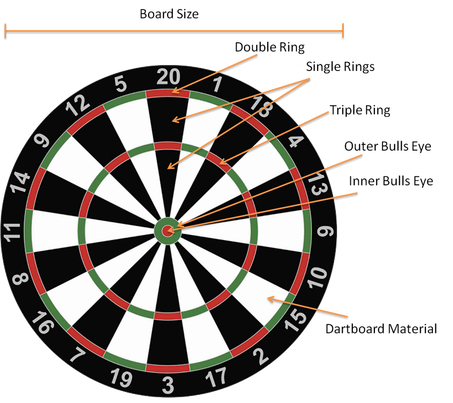Darts 101 > Anatomy of Darts
Anatomy of Darts and Dartboards
Ask any professional sports player what type of equipment they use and they will have a favorite brand because they have tested everything on the market. Darts is no different in that any serious dart player understands they need to know what they are throwing in order to master the game. Dartboards and darts vary in style, quality, weight, and many other factors that require an in depth knowledge about the materials used to construct them. Learn more about the anatomy of both below.
|
Dartboard Anatomy
|
Anatomy of a Dart
- Point or Tip — The point or also known as the tip of a dart is what makes contact with and sticks in the dartboard. Points can be soft tip, steel tip, or even magnetic. Soft tip darts are used with electronic boards, while steel tip are made for traditional dartboards.
- Barrel — The barrel is where most people typically grip the dart with their fingers to hold it. The barrel is extremely important because it is where most of the weight in the dart is carried which balances out the flight. Barrels are typically made in weights of 16 grams to 30 grams with heavier darts flying fast and lighter darts being more susceptible to throwing variations. Having a good balance between the weight of the dart and its overall diameter is important. Tungsten material offers a heavy dart with a thin diameter, making them the best dart on the market for this reason.
- Shaft — The shaft makes up the main body of the dart and extends the full length to the back of it where the flight is connected. The shaft stabilizes the trajectory of the flight path. If you notice your darts are wobbling during flight, it is likely that your shafts are too lengthy causing them to shift during its way to the dartboard.
- Flight — The flight on a dart is on the tail end and attaches to the shaft. Flights are used to balance and stabilize the dart during flight. There are typically 4 prongs on a flight with a variety of different shapes and materials used to make them.
- Weight of a Dart — The weight is typically measured in grams and can vary depending on the style and materials used. Darts can weigh anywhere from 12 grams all the way up to 50 grams with all of the various components combined, with a majority of the weight in the barrel of the dart.






